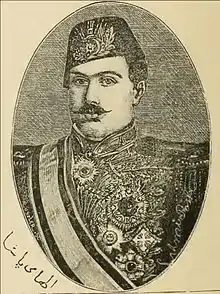Ibrahim Ilhami Pasha
Ibrahim Ilhami Pasha (Arabic: إبراهيم إلهامي باشا; 3 January 1836 – 9 September 1860) was the only surviving son of Abbas I of Egypt and his wife Mahivech Hanim.
| Ibrahim Ilhami Pasha | |
|---|---|
 | |
| Born | 3 January 1836 Cairo, Egypt |
| Died | 9 September 1860 (aged 24) Bebek Palace, Istanbul, Ottoman Empire |
| Burial | |
| Spouse | |
| Issue | |
| Father | Abbas I of Egypt |
| Mother | Mahivech Hanim |
Ibrahim Ilhami was circumcised in 1849.[1] In July 1854, following his father Abbas's death, his loyalists unsuccessfully attempted to raise him to the throne.[2]
Personal life
In March 1854, a messenger from Istanbul announced the betrothal of Ibrahim Pasha to Münire Sultan, daughter of Abdulmejid I and his wife Verdicenan Kadın. Large public celebrations were proclaimed and the viceroy was reported to be highly pleased with the news.[3][4] Ibrahim Pasha sent her a solitaire ring, solitaire earrings and a briolette as her betrothal gifts. There were also all sorts of perfumes covered with transparent lids and bowls of musk and mastic. There were crystal carafes containing syrup and porcelain vases from Saxony holding all sorts of preserves, and finally there were both eastern and western candies on plates of Chinese porcelain.[5] Verdicenan Kadın gave some of these perfumes and morsels of food to other princesses, and also distributed them equally to the people in her entourage.[6][7] The engagement took place in the Şemsipaşa Palace.[8]
The marriage took place on 10 August 1854 in at the Baltalimanı sahilhane, Istanbul.[9] The marriage was consummated on 31 July 1857.[10] The couple were given a palace located at Findiklı as their residence.[11]
Ibrahim had three consorts, Nasrin Qadin (died 1871), mother of Princess Emina Ilhamy, born in 1858, Jeshmi Ahu Qadin (died 1905), mother of Princess Zeynab Ilhamy, born in 1859, and Ashiq Bayran Qadin (died 1878), mother of Tevhide Ilhamy, born in 1860.[12] The eldest, Emine, married Tewfik Pasha, eldest son of Isma'il Pasha, and the younger, Zeynab, married Mahmud Hamdi Pasha, fifth son of Isma'il Pasha.[13]
Death
Prince Ibrahim died on 9 September 1860 when his boat capsized while crossing the Bosphorus, near Bebek Palace, at what is now Bebek Bay.[14][15]
Issue
Prince Ibrahim Ilhami had three daughters:[16]
- Princess Emina Ilhamy (24 May 1858, Istanbul – 19 June 1931, Bebek, Bosphorus, Istanbul, Turkey);
- Princess Zeynab Ilhamy (29 December 1859, Istanbul — 17 May 1918, Cairo, Egypt);
- Princess Tevhide Ilhamy[17] (1860, Istanbul — 1882, Cairo);
Ancestry
| Ancestors of Ibrahim Ilhami Pasha | |||||||||||||||||||||||||||||||||||||||||||||||||||||||||||||||||||||||||||||||||||||||||||||||||||||||||||||||||||||||||||||||||||||||||||||||||||||||||||||||||||||||||||||||||||||||||||||||||||||||||||||||||||||||||||||||||||||||||||||||||||||||||||||||||||||||||||||||||||||||||||||||||||||||||||||||||||||||||||||||||||||||||||||||||||||||||||||||||||||||||||||||||||||||||||||||||||||||||||||||||||||||||||||||||||||||||||||||||||||||||||||||||||||||||||||||||||
|---|---|---|---|---|---|---|---|---|---|---|---|---|---|---|---|---|---|---|---|---|---|---|---|---|---|---|---|---|---|---|---|---|---|---|---|---|---|---|---|---|---|---|---|---|---|---|---|---|---|---|---|---|---|---|---|---|---|---|---|---|---|---|---|---|---|---|---|---|---|---|---|---|---|---|---|---|---|---|---|---|---|---|---|---|---|---|---|---|---|---|---|---|---|---|---|---|---|---|---|---|---|---|---|---|---|---|---|---|---|---|---|---|---|---|---|---|---|---|---|---|---|---|---|---|---|---|---|---|---|---|---|---|---|---|---|---|---|---|---|---|---|---|---|---|---|---|---|---|---|---|---|---|---|---|---|---|---|---|---|---|---|---|---|---|---|---|---|---|---|---|---|---|---|---|---|---|---|---|---|---|---|---|---|---|---|---|---|---|---|---|---|---|---|---|---|---|---|---|---|---|---|---|---|---|---|---|---|---|---|---|---|---|---|---|---|---|---|---|---|---|---|---|---|---|---|---|---|---|---|---|---|---|---|---|---|---|---|---|---|---|---|---|---|---|---|---|---|---|---|---|---|---|---|---|---|---|---|---|---|---|---|---|---|---|---|---|---|---|---|---|---|---|---|---|---|---|---|---|---|---|---|---|---|---|---|---|---|---|---|---|---|---|---|---|---|---|---|---|---|---|---|---|---|---|---|---|---|---|---|---|---|---|---|---|---|---|---|---|---|---|---|---|---|---|---|---|---|---|---|---|---|---|---|---|---|---|---|---|---|---|---|---|---|---|---|---|---|---|---|---|---|---|---|---|---|---|---|---|---|---|---|---|---|---|---|---|---|---|---|---|---|---|---|---|---|---|---|---|---|---|---|---|---|---|---|---|---|---|---|---|---|---|---|---|---|---|---|---|---|---|---|---|---|---|---|---|---|---|---|---|---|---|---|---|---|---|---|---|---|---|---|---|---|---|---|---|---|---|---|---|---|---|---|---|---|---|---|---|---|---|---|---|---|---|---|---|---|---|---|---|---|---|---|---|---|---|---|---|---|---|---|---|---|---|---|---|---|
| |||||||||||||||||||||||||||||||||||||||||||||||||||||||||||||||||||||||||||||||||||||||||||||||||||||||||||||||||||||||||||||||||||||||||||||||||||||||||||||||||||||||||||||||||||||||||||||||||||||||||||||||||||||||||||||||||||||||||||||||||||||||||||||||||||||||||||||||||||||||||||||||||||||||||||||||||||||||||||||||||||||||||||||||||||||||||||||||||||||||||||||||||||||||||||||||||||||||||||||||||||||||||||||||||||||||||||||||||||||||||||||||||||||||||||||||||||
References
- Fuess, Albrecht; Hartung, Jan-Peter (June 3, 2014). Court Cultures in the Muslim World: Seventh to Nineteenth Centuries. Routledge. p. 252. ISBN 978-1-136-91781-3.
- Cuno, Kenneth M. (April 1, 2015). Modernizing Marriage: Family, Ideology, and Law in Nineteenth- and Early Twentieth-Century Egypt. Syracuse University Press. p. 35. ISBN 978-0-815-65316-5.
- Toledano, Ehud R. (February 13, 2013). State and Society in Mid-Nineteenth-Century Egypt. Cambridge University Press. p. 53. ISBN 978-0-521-53453-6.
- Warner, Jayne L. (2001). Cultural Horizons: A festschrift in honor of Talat S. Halman, Volume 1. Syracuse University Press. p. 161. ISBN 978-0-815-68132-8.
- Isin, Mary (January 8, 2013). Sherbet and Spice: The Complete Story of Turkish Sweets and Desserts. I.B.Tauris. p. 48. ISBN 978-1-848-85898-5.
- Lewis, Reina; Micklewright, Nancy (July 1, 2006). Gender, Modernity and Liberty: Middle Eastern and Western Women's Writings: A Critical Sourcebook. I.B.Tauris. p. 186. ISBN 978-1-860-64956-1.
- McWilliams, Mark (July 1, 2012). Celebration: Proceedings of the Oxford Symposium on Food and Cookery 2011. Oxford Symposium. p. 154. ISBN 978-1-903-01889-7.
- Pakalın, Mehmet Zeki (1954). Osmanli tarih deyimleri ve terimleri sözlüğü, Volume 3. Millî Eğitim Basımevi. p. 349.
- Badem, Candan (2010). “The” Ottoman Crimean War: (1853 - 1856). BRILL. pp. 320 n. 96. ISBN 978-9-004-18205-9.
- Sakaoğlu, Necdet (2008). Bu mülkün kadın sultanları: Vâlide sultanlar, hâtunlar, hasekiler, kadınefendiler, sultanefendiler. Oğlak Yayıncılık. p. 623. ISBN 978-9-753-29623-6.
- Mülayim, Selçuk; Akşit, İlhan (2005). Turkish Art and Architecture in Anatolia & Mimar Sinan. Akşit. p. 195. ISBN 978-9-757-03922-8.
- Catalogue of the Abbas Hilmi II Papers. Durham University Library. 2020. p. 333.
- Tugay, Emine Foat (1963). Three Centuries: Family Chronicles of Turkey and Egypt. Oxford University Press. p. 100.
- Adra, Jamil (2005). Genealogy of the Imperial Ottoman Family 2005. pp. 8.
- Hassan, Hassan (2000). In the House of Muhammad Ali: A Family Album, 1805-1952. American Univ in Cairo Press. p. 103. ISBN 978-9-774-24554-1.
- Malortie, Karl Von (1882). Egypt: Native Rulers and Foreign Interference. W. Ridgway. pp. 300–301.
- İstanbul su külliyâtı: Vakıf su defterleri: Bogazici ve Taksim sulari 2 (1813-1928). 1997. p. 83. ISBN 978-9-758-21504-1.